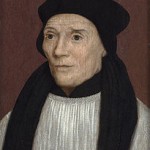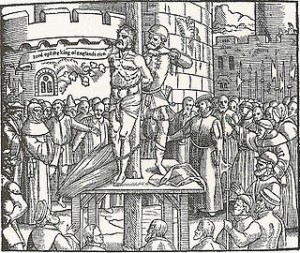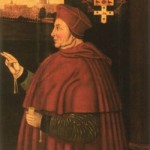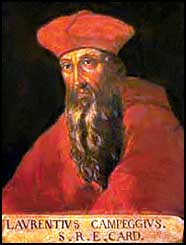From the BBC’s A History of Britain. Simon Schama takes us through the English Reformation with some great video, in an episode entitled “Burning Convictions.” Part 1 of 6 is below.
http://www.youtube.com/watch?v=Tq6e6V3btp8
In Part I we set the stage for the beginnings of the English Reformation. Now its time to look at what the religious climate was in England immediately before the breach with Rome and the beginnings of the Church of England.
The Roman Catholic Church in early 16th century England was very much like the Catholic Church in the remainder of Europe. Mass was said in Latin, the Bible was not available to lay people, priests did not marry and a person could receive forgiveness of sins by the purchase of indulgences from the Church. Masses were said for the dead to allow them to escape purgatory and priests were paid from the estate of the deceased to say Mass regularly on their behalf.
The Reformation on the continent did not go unnoticed in England, however. As the laity began to become more educated, reforming ideas from Europe became to be regularly discussed in England as well. The printing press proved to be a major catalyst in the Reformation, both in England and the continent, especially considering that you didn’t need to know Latin or Greek, or be a university scholar or in Holy Orders, to be able to read and discuss religious issues.
By 1521 Lutheran books were coming into England and people were discussing religious issues. Luther, a German monk and New Testament scholar, challenged the Roman Catholic Church’s views on salvation, indulgences, and the Roman Catholic doctrine of transubstantiation, which holds that the bread and wine consecrated by the priest during Mass actually becomes the physical body and blood of Christ.
The reaction to this by the English Church and the Crown was swift. Bishop John Fisher, along with other English bishops, led the charge against Luther’s works and a ceremonial burning of Luther’s works was held at St. Paul’s Cathedral in London in 1521.
Other notable English clergy were involved in discussing Luther’s ideas, including a group of Cambridge scholars many of whom would become first generation English reformers (and martyrs) including William Tyndale, Thomas Parker, Hugh Latimer, Thomas Cranmer, and Nicholas Ridley.
William Tyndale, a committed reformer, translated the Bible into English. Fearing for his safety he traveled to Germany and met Luther. He translation of the New Testament appeared in England in the late 1520’s, and he produced other writings that discussed the supremacy of Scripture over everything else. He was eventually tracked down by English agents in Brussels, and in 1536 condemned to death for heresy. He was strangled to death and then burned on the stake, as depicted below in Foxe’s Book of Martyrs, which chronicled the martyrs of the English Reformation. Tyndale’s final words were, “Lord, open the King of England’s eyes.”
Henry VIII’s response to Lutheran ideas was similar to that of the bishops. Henry wrote a response to Luther, opposing Lutheran doctrine and for the supremacy of the Pope. For his efforts, he was rewarded with the title of “Defender of the Faith” by the Pope, a title that English monarchs carry to this day.
If Luther’s ideas gave some in England reason for thought, the actions of the English clergy gave rise to strong feelings of anti-clericalism. The poster child for anticlericalism at the time was Henry’s chancellor, Cardinal Wolsey. Wolsey was held multiple titles including Cardinal, Archbishop of York, and a number of other bishoprics, which was not uncommon at the time. Fabulously wealthy, he built Hampton Court Palace (which he would later give to Henry VIII in a desperate attempt to save himself from being charged with treason-it didn’t work), and endowed a college at Oxford. Like many of the clergy at the time he had a mistress and several illegitimate children
Wolsey, who arose from humble beginnings, was given significant power by Henry VIII for handling the day to day business of the monarchy. Wolsey also arranged to be appointed a papal legate, which meant he acted in the name of the Pope in England. His significant power and wealth caused resentment among other bishops and members of Henry’s court, so much that once he failed to please the King, his downfall was assured.
That downfall stemmed from Henry’s attempts to get an annulment from his marriage to Catherine of Aragon. Remember that by 1525 Catherine had failed to produce a male heir for Henry and Henry’s attentions were focused on Anne Boleyn. Wolsey tried to intervene on Henry’s behalf with Pope Clement to grant an annulment, but Clement would not overrule the dispensation that had been given to Henry by then-Pope Julius. Clement’s refusal to grant an annulment was undoubtedly influenced by the fact that Catherine of Aragon’s uncle was Charles V, Holy Roman Emperor, who actually attacked Rome in 1527 and kept Pope Clement VII under house arrest for a while.
By 1527 Henry had decided to marry Anne and began annulment proceedings. Clement sent another cardinal and papal legate, Cardinal Campeggio, who presided with Wolsey inannulment hearings inn England in 1528. Unfortunately, for Wolsey, Henry did not get the result he wanted, an annulment, and the case was remanded to Rome for a decision by the Pope. Given the situation with Charles V, it was obvious that the result was not going to be good for Henry.
Wolsey’s standing with Henry was significantly diminished after the case was sent back to Rome, especially after Anne and her supporters (who were pro-Reformation) at Court convinced Henry that Wolsey was putting the interests of the Church over Henry’s. Wolsey was deprived of the Chancellor’s office and forced to return to being Archbishop of York, the second-ranking primate in England (the Archbishop of Canterbury is first), and actually had to go to York, where he had never been before, although he was Archbishop (the requirement for Bishops to reside in their seas was one product of the Reformation). However this wasn’t enough for the anticlerical Reform-minded activists at Court, and Wolsey was eventually was charged with treason. He was charged under an ancient common law principle that it was illegal to serve another monarch (the Pope) at the expense of the King, and brought to Court under a writ of praemunire. Apparently, all of Wolsey’s actions as papal legate were illegal! Who knew?
Wolsey died in 1530 enroute to the Tower of London of natural causes and never faced the executioner. His final words included, “If I had served God as diligently as I have done the King, he would not have given me over in my grey hairs.”
At Court, Wolsey was gone and there was a strong reforming influence led by Anne and her supporters. Henry was determined to get his marriage to Catherine overturned, however, and began to take steps to assume more control of the English church. While Reforming principles were on the minds of many at Court, Henry remained a fairly content Catholic in matters of doctrine.
So, perhaps, maybe it was really all about Anne. In Henry’s mind it probably was. In the next post, we’ll examine the actual breach with Rome and learn about the key players involved, most of whom were committed reformers, and how they used the breach as an opportunity to bring reforming principles to England.







Recent Comments